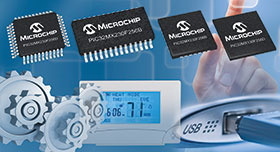Lower-power models added to PIC32MX range
16 August 2017
DSP, Micros & Memory

Microchip announced a new family of eXtreme Low Power (XLP) technology 32-bit microcontrollers (MCUs). The PIC32MX1/2 XLP family offers current PIC32MX customers an easy migration path to achieve higher performance at much lower power, enabling both increased functions and longer battery life in portable applications. The new family increases performance in small pin-count devices with little code rework for existing customers.
Microchip’s XLP technology is designed for wearable technology, wireless sensor networks and other smart connected devices, and offers low-current operating modes for run and sleep, where extreme low-power applications spend 90% to 99% of their time. XLP technology enables deep sleep currents down to 673 nA. The new devices offer over 40% higher performance than the existing PCI32MX1/2 portfolio while reducing average run currents by 50%.
The PIC32MX1/2 XLP family offers a range of memory configurations with 128/256 KB Flash and 32/64 KB of RAM in packages ranging from 28 to 44 pins. They also include a diverse set of peripherals at a low cost, including I2S for digital audio, 116 DMIPS performance for executing audio and advanced control applications, a 10-bit, 1 MSps 13-channel ADC and serial communications peripherals. The PIC32MX2 series also supports USB device, host and OTG functionality.
For more information contact Shane Padayachee, Avnet South Africa, +27 (0)11 319 8600, [email protected], www.avnet.co.za
Further reading:
ESP32-C6 achieves PSA-L2
iCorp Technologies
DSP, Micros & Memory
Espressif Systems recently announced that its ESP32-C6 microcontroller has achieved PSA Certified Level 2 (PSA-L2) security certification, making it the first RISC-V-based MCU to reach this level.
Read more...
Microprocessor with integrated NPU
Avnet Silica
DSP, Micros & Memory
The RZ/G3E from Renesas is a microprocessor integrated with quad CPU and NPU in one chip, improving power efficiency, reliability, and security.
Read more...
Nordic Semiconductor launches nRF Connect SDK Bare Metal option for nRF54L series
Avnet Silica
DSP, Micros & Memory
This is a new, RTOS-independent software solution for Bluetooth LE development, designed to ease developers’ migration from the legacy nRF5 SDK and nRF52 series to the next-generation nRF54L series.
Read more...
Dual-core support in NECTO Studio
DSP, Micros & Memory
MIKROE recently announced that version 7.3.0 of its NECTO Studio Integrated Development Environment now supports dual-core MCUs, allowing designers to program and debug each core independently.
Read more...
Post Quantum Cryptographic firmware library
DSP, Micros & Memory
The STM32 post-quantum cryptographic library enables developers to satisfy application requirements for any combination of data integrity, confidentiality, identification/authentication, and nonrepudiation.
Read more...
MultiVolt series of oscillators
Future Electronics
DSP, Micros & Memory
The ECS-3225MVQ from ECS Inc. is a compact, quartz-based MultiVolt oscillator designed for precision timing in automotive, industrial, and portable electronic systems.
Read more...
MCU platform for battery-powered devices
Altron Arrow
DSP, Micros & Memory
The MCX W23 is a new dedicated wireless MCU platform from NXP for battery-powered sensing devices.
Read more...
Drive innovation with AURIX TriCore MCUs
Future Electronics
DSP, Micros & Memory
Infineon’s AURIX TriCore family balances safety, performance, and energy efficiency to offer a scalable and future-ready portfolio.
Read more...
Elevate your motor control designs
EBV Electrolink
DSP, Micros & Memory
Built on an Arm Cortex-M33 core running up to 180 MHz, the MCX A34 family combines high-performance math acceleration and advanced motor control subsystems to unlock efficient motor drive solutions.
Read more...
Embedded platform for compute-intensive applications
iCorp Technologies
DSP, Micros & Memory
The Quectel QSM368ZP-WF is a fully featured embedded ARM platform optimised for compute-intensive industrial and IoT applications.
Read more...


